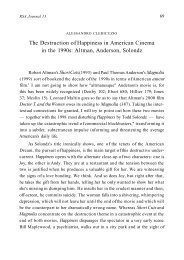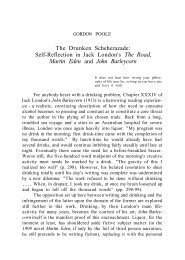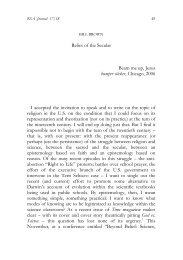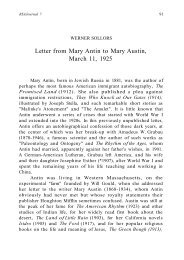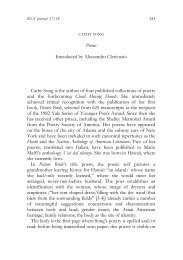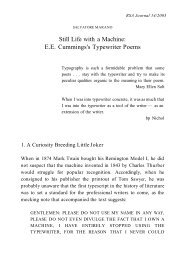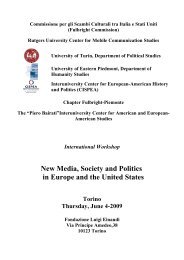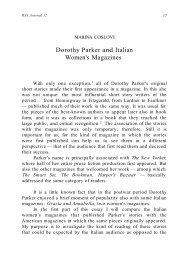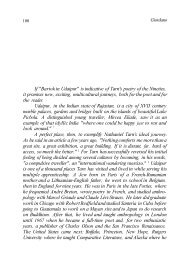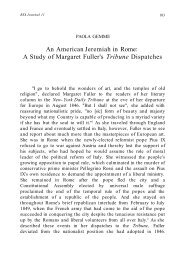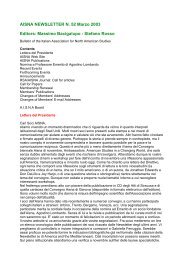Myth and Carnival in Robert Coover's The Public Burning - aisna
Myth and Carnival in Robert Coover's The Public Burning - aisna
Myth and Carnival in Robert Coover's The Public Burning - aisna
- No tags were found...
Create successful ePaper yourself
Turn your PDF publications into a flip-book with our unique Google optimized e-Paper software.
20 Da<strong>in</strong>ottocouldn't underst<strong>and</strong>, though, was the Rosenbergs' stay<strong>in</strong>g poor. Notthat poor. Not <strong>in</strong> America. (PB 115)Poverty is a crime aga<strong>in</strong>st the American myth, or at least "the poor,given their resentments, were not to be trusted, <strong>and</strong> if there were anytrouble, it was smart to look there first" (PB 182).Coover offers his view of myth as totaliz<strong>in</strong>g ideology, <strong>and</strong>,accord<strong>in</strong>gly, engages <strong>in</strong> a powerful critique of America—"a civilization,"as Frederick Turner has po<strong>in</strong>ted out, "that has substitutedhistory for myth as a way for underst<strong>and</strong><strong>in</strong>g life" (Turner xi). Asubsidiary Toquevillian theme is also present: <strong>in</strong> "Æsop's Forest"Coover refers to a "democracy of the dead," <strong>and</strong> <strong>in</strong> <strong>The</strong> <strong>Public</strong> Burn<strong>in</strong>ghe has Nixon characterize the American myth as "a dream of love <strong>and</strong>death." History be<strong>in</strong>g public op<strong>in</strong>ion (as Uncle Sam has told us) <strong>and</strong>public op<strong>in</strong>ion be<strong>in</strong>g created by <strong>The</strong> New York Times <strong>and</strong> by all thek<strong>in</strong>g's men <strong>in</strong> terms of a monologue of power, the History of Americabecomes the history of a public op<strong>in</strong>ion that suppresses the "other"(the Rosenbergs are radicals, communists, Jewish, <strong>and</strong> poor) to ensureuniformity <strong>and</strong> a profound sympathy with the revealed Truth. <strong>The</strong>American democratic ideal becomes, <strong>in</strong> Kermode's term, a myth fromwhich it is strenuous to escape. It becomes a prison, a doom—a hell.Like the classical underworld, Uncle Sam's theater for theexecution consists of three levels. "Underground... [there is the] TimesSquare subway station, [where] Uncle Sam is busily sort<strong>in</strong>g out theofficial celebrants <strong>and</strong> l<strong>in</strong><strong>in</strong>g them up" (PB 401). <strong>The</strong> subway is thepassageway that leads from the liv<strong>in</strong>g world to Times Square, thecenter of Uncle Sam's hell where the Rosenbergs will be executed <strong>and</strong>Nixon sodomized. <strong>The</strong>n there is the S<strong>in</strong>g S<strong>in</strong>g prison, where, like <strong>in</strong> thepit of Tartarus, the Rosenbergs <strong>and</strong> others who have offended the godswait for their death. Between Times Square <strong>and</strong> S<strong>in</strong>g S<strong>in</strong>g runs theHudson, which Nixon crosses twice <strong>in</strong> the taxi-cab of a Charon-likePhantom. As if cross<strong>in</strong>g the Lethe, both times he forgets what he has todo <strong>in</strong> S<strong>in</strong>g S<strong>in</strong>g, what his name is <strong>and</strong> what he has to say <strong>in</strong> TimesSquare. This is the allegorical American hell <strong>in</strong> which the Rosenbergsare burned, Ethel last:Her body, sizzl<strong>in</strong>g <strong>and</strong> popp<strong>in</strong>g like firecrackers, lights up with the forceof the current, cast<strong>in</strong>g a flicker<strong>in</strong>g radiance on all those around her, <strong>and</strong>



